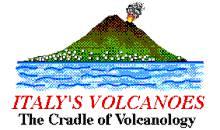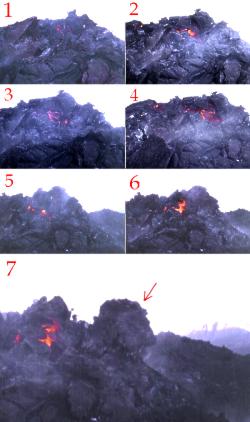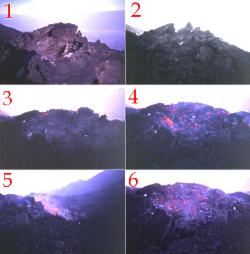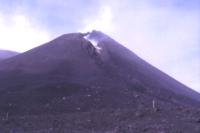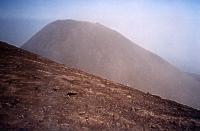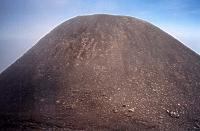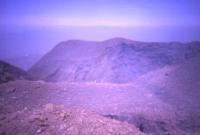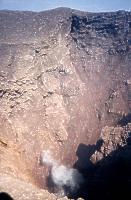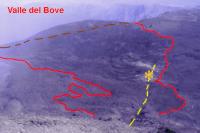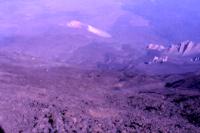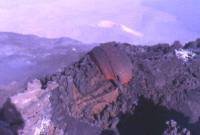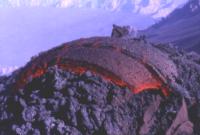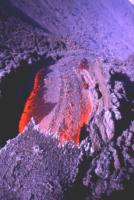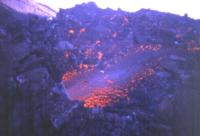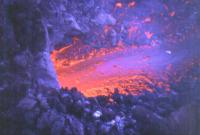|
Previous Etna news
|
Do you plan to visit Etna
in the near future?
Check the weather
forecasts for the Etnean area!
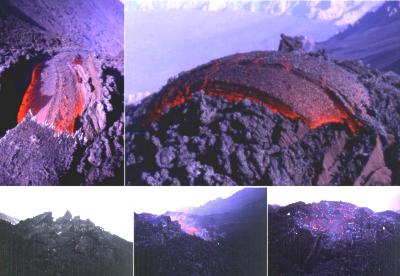
Effusive vents and lava tumulus on the western slope of Valle del Bove on 12 May 1999. See photos below for more detail.
13 May 1999
During the past 12 days (since 30 April), little significant
change has affected the effusive activity initiated on 4 February at
the SE base of the SE Cone. Lava is still flowing from the area of the
4 February fissure through a lava tube and appears at the surface only
at about 2600 m elevation on the western wall of Valle del Bove. Active
lava fronts do not extend below 2000 m elevation.
On 12 May, Boris Behncke (IGGUC) and Giuseppe Scarpinati (Italian delegate
of the Association
Volcanologique Europèenne, Paris) visited the summit area
of Etna, including Bocca Nuova and SE Crater, and entered the Valle
del Bove to get a close view of the active effusive vents. The summit
craters were exceptionally quiet, apart from near continuous but essentially
passive emissions of light brown ash from the northwestern vent of Bocca
Nuova. This activity, which was most likely caused by internal collapse
related to the slow sinking of the magma column in the conduit, was
entirely noiseless and ash plumes barely rose above the crater rim.
A deposit several centimeters in thickness covered the southern, southeastern
and eastern sides of the main summit cone.
After descending from the main summit cone to the saddle which separates
it from the SE Cone, Behncke climbed to the summit of the SE Cone whose
western flank was found to be extraordinarily steep (up to 50 degrees,
much more than is common on volcanic cones) and climbing was only possible
because it consisted of agglutinated bombs. The crater was practically
gas-free and its interior was perfectly visible, so that it could be
stated that its floor had collapsed and the conduit was no longer open.
There was, however, some gas and vapor emission from the upper part
of the fracture which had split the southeastern flank of the cone on
4 February.
There was no visible activity anywhere above the Valle del Bove rim
in the lava field of the eruption initiated on 4 February, the only
surface flows appearing about 200-250 m below the original eruptive
fissure, in Valle del Bove. Behncke and Scarpinati reached the main
effusive vent area - there is now only one active lava tube through
which lava is transported to the effusive vents - which did not appear
to have changed significantly since Behncke's previous visit on 30 April.
At the time of their arrival, lava was issuing from two ephemeral vents
(ephemeral, because such vents frequently change in configuration and
location) on the northern and eastern sides of a large "tumulus".
Tumuli of this kind form by the continuous pressure of lava pushing
from below towards the surface, and by lava oozing upwards through cracks
in older lavas at the surface (see the fourth of the photos of the 14
April visit to the active lava flows). The tumulus was about 10-15 m
across and consisted of uplifted, tilted, craggy blocks of older lava
and minor volumes of more recently extruded lava, much of the latter
being very smooth-surfaced pahoehoe. The northern effusive vent fed
a well-channelized flow about 0.3-0.4 m wide while from the vent on
the eastern side of the tumulus lava was squeezed out like toothpaste,
which then descended the steep eastern face of the tumulus.
During investigation of the tumulus and of the effusive vents, Behncke
and Scarpinati continuously heard ominous cracking and knocking sounds
from below, and small rockfalls from the sides of the tumulus were frequently
observed. At the same time, the rocks at the surface of the tumulus
were seen to be slowly fracturing. It was evident that magma was forcefully
pushing from below, causing uplift and lateral spreading of the tumulus,
and lava was seen rising slowly within cracks between the blocks at
the surface. After about 15 minutes of observation, Behncke and Scarpinati
left the unstable tumulus area and continued their observation from
a point some 15 m upslope. For another 20-30 minutes, the tumulus gradually
extended in all directions, while portions of its southern and southeastern
margin appeared to be subsiding, as magma was instruded into it at a
depth of a few meters. Fracturing was also observed on the slope above
the tumulus, indicating that a larger volume of magma was arriving at
the end of the feeder tube and nearing the surface.
As time passed, the large blocks of older lava showed more and more
cracks and began to fall to pieces while ever larger rockfalls and collapses
occurred on the flanks of the tumulus. After this, the entire area of
the tumulus became highly mobile, and its eastern and southeastern sides
which were precariously perched above the steep Valle del Bove slope
began to slide downhill, producing spectacular cascades of more or less
incandescent blocks and exposing the fluid, highly incandescent heart
of the tumulus. The most dramatic phase which lasted no longer than
5 minutes saw the virtual unfolding of the whole structure as
older blocks of lava were slipping from the overwhelmingly mobile lava
now exposed at the surface, and crashed down the steep slope into the
Valle del Bove. Where the two observers had walked and photographed
only half an hour before, an incandescent chasm 15 m wide and 5-6 m
deep opened, and lava slowly flowed from draining lava tubes which had
until shortly before fed the two ephemeral vents seen at the beginning
of the visit. Fresh lava welled up at the western end of the collapse
depression, rapidly filling it and spilling over its southeastern rim,
causing further spectacular rockfalls. Some rocks at least 20 cubic
meters in volume were seen to fall, with fresh incandescent lava being
attached to them like glue. The overflowing lava appeared to be more
voluminous than that which had previously issued from the two ephemeral
vents, and it is probable that the arrival of this larger volume had
caused the spectacular collapse of the tumulus.
The previously active flows, cut off from their supply, soon stagnated,
and small lava tubes with still-incandescent walls which had fed the
effusive vents became visible; unfortunately it was difficult to approach
these places due to the enormous heat radiated from the area. Fresh
lava spilled down in a southeasterly direction, forming two branches
which travelled 100-150 m in about 30 minutes.
The destruction of the tumulus, spectacular though it was, was not a
geologically significant event and does not mean that the physical conditions
of the present effusive activity have changed, although it might be
the result of a minor, temporary increase in the effusion rate. It has
to be remembered that the effusive vents at the Valle del Bove slope
are no true eruptive vents, but they are instead the point where the
lava leaves a feeder tube, about 1 km away from the area of the original
eruptive fissure.
A more significant change observed during the 12 May visit is the obstruction
of the SE Crater which had until recently served as a degassing valve
for the magma erupting from its base. It is possible, though, that degassing
is equally occurring from Bocca Nuova, which is clearly connected to
the present effusive activity, as evidenced by the cessation of magmatic
activity in this crater immediately after the beginning of the effusive
activity on 4 February.
This effusive activity which continues since 98 days without interruption
has diminished significantly during the past two months, but it may
continue for weeks to come.
Page set up on 26 May 1999
